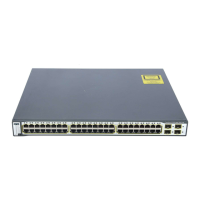Contents
xxix
Catalyst 3750 Switch Software Configuration Guide
78-16180-02
PIMv1 and PIMv2 Interoperability 36-9
Auto-RP and BSR Configuration Guidelines 36-10
Configuring Basic Multicast Routing 36-10
Configuring a Rendezvous Point 36-12
Manually Assigning an RP to Multicast Groups 36-12
Configuring Auto-RP 36-14
Configuring PIMv2 BSR 36-18
Using Auto-RP and a BSR 36-22
Monitoring the RP Mapping Information 36-23
Troubleshooting PIMv1 and PIMv2 Interoperability Problems 36-23
Configuring Advanced PIM Features 36-23
Understanding PIM Shared Tree and Source Tree 36-23
Delaying the Use of PIM Shortest-Path Tree 36-25
Modifying the PIM Router-Query Message Interval 36-26
Configuring Optional IGMP Features 36-27
Default IGMP Configuration 36-27
Configuring the Switch as a Member of a Group 36-27
Controlling Access to IP Multicast Groups 36-28
Changing the IGMP Version 36-29
Modifying the IGMP Host-Query Message Interval 36-30
Changing the IGMP Query Timeout for IGMPv2 36-31
Changing the Maximum Query Response Time for IGMPv2 36-31
Configuring the Switch as a Statically Connected Member 36-32
Configuring Optional Multicast Routing Features 36-32
Enabling CGMP Server Support 36-33
Configuring sdr Listener Support 36-34
Enabling sdr Listener Support 36-34
Limiting How Long an sdr Cache Entry Exists 36-35
Configuring an IP Multicast Boundary 36-35
Configuring Basic DVMRP Interoperability Features 36-37
Configuring DVMRP Interoperability 36-37
Configuring a DVMRP Tunnel 36-39
Advertising Network 0.0.0.0 to DVMRP Neighbors 36-41
Responding to mrinfo Requests 36-42
Configuring Advanced DVMRP Interoperability Features 36-42
Enabling DVMRP Unicast Routing 36-43
Rejecting a DVMRP Nonpruning Neighbor 36-43
Controlling Route Exchanges 36-46
Limiting the Number of DVMRP Routes Advertised 36-46

